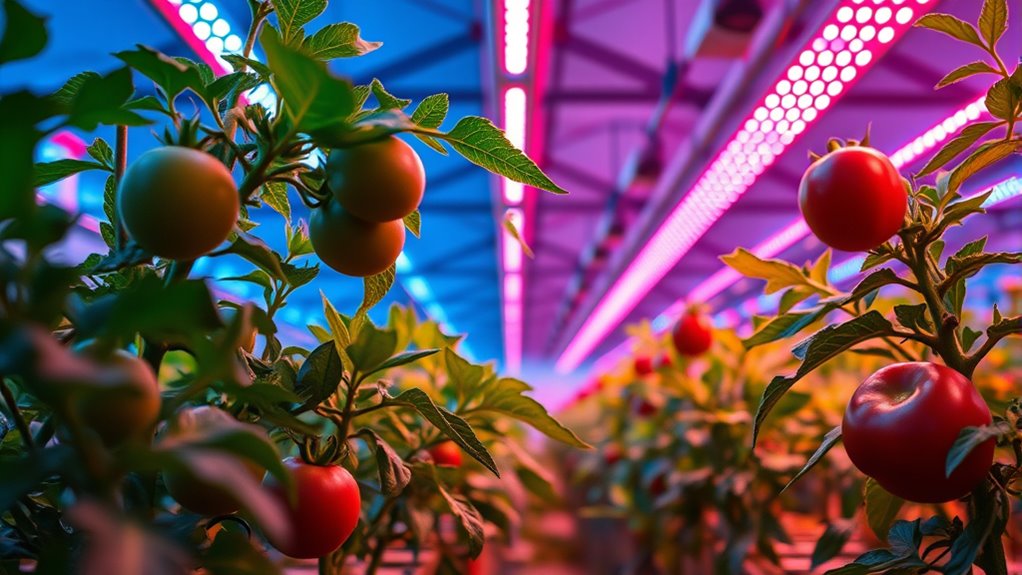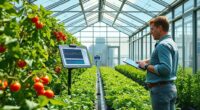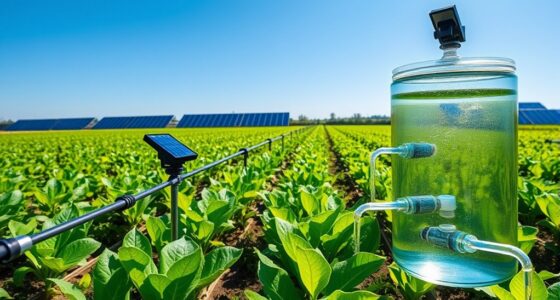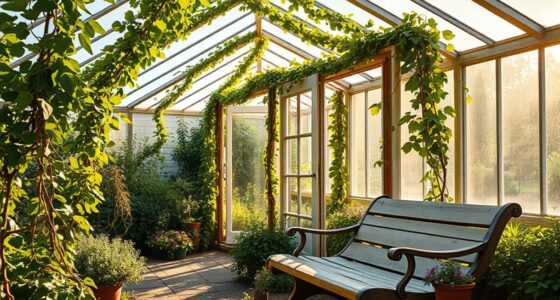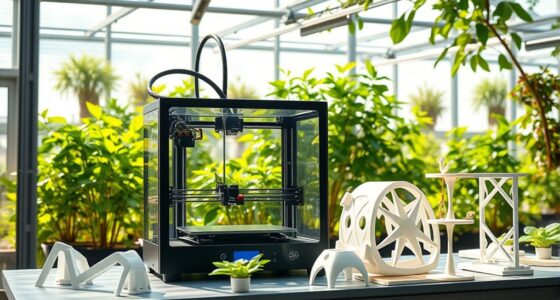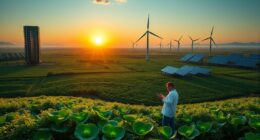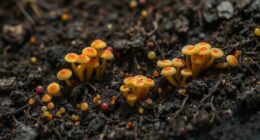By customizing LED light spectra for each crop, you can deliver exactly the wavelengths needed to promote ideal growth, higher yields, and better quality. Tailored lighting makes photosynthesis more efficient, accelerates development, and reduces energy waste by focusing light where plants need it most. This precision allows you to lower energy costs and create ideal growth conditions. Keep exploring to discover how spectrum optimization can maximize your crop production and operational efficiency.
Key Takeaways
- Customize light spectra to match specific crop growth stages for optimal development.
- Use tailored LED recipes to enhance photosynthesis and crop quality effectively.
- Adjust wavelength combinations to promote flowering, fruiting, or foliage growth as needed.
- Optimize energy efficiency by delivering only necessary wavelengths, reducing waste.
- Leverage spectrum control to create stable indoor environments and maximize crop yields.
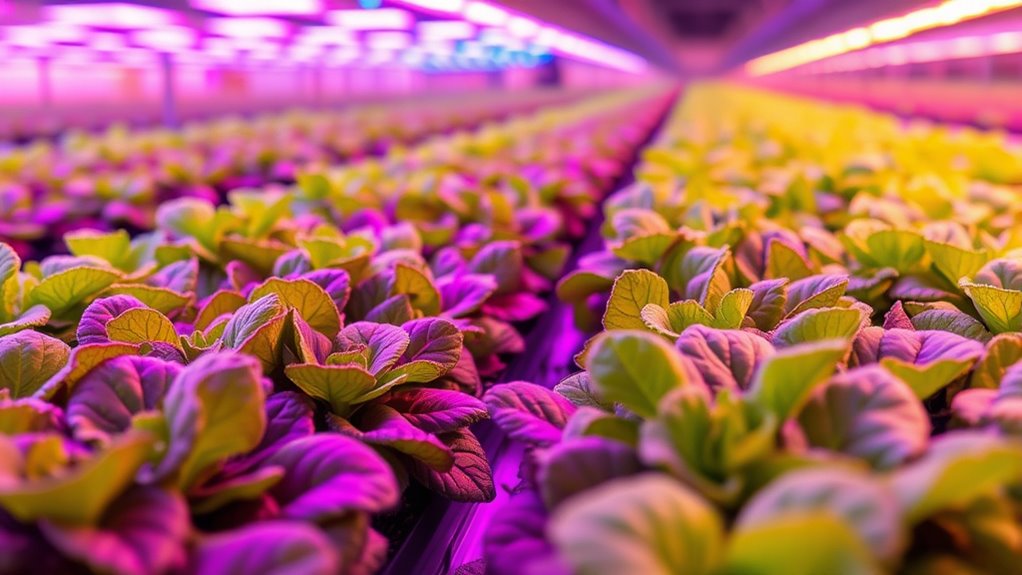
Have you ever wondered how LED lighting can boost crop growth? The truth is, tailored LED lighting plays a crucial role in optimizing plant growth by delivering specific light spectra that meet each crop’s unique needs. Unlike traditional lighting systems, LEDs allow you to customize the intensity and wavelength, guaranteeing your plants receive the perfect light for photosynthesis and development. This precise control not only accelerates growth rates but also improves the quality of your crops. When you choose the right spectrum, you’re giving your plants the tools they need to thrive, whether that’s maximizing leaf expansion, flowering, or fruiting.
Tailored LED lighting optimizes crop growth by providing the perfect spectrum for healthy, high-quality yields.
One of the most significant advantages of LED lighting is its energy efficiency. Because LEDs focus light more directly onto plants and can be tuned to emit only the wavelengths necessary for optimal growth, they consume less power compared to conventional lighting options. This means you can achieve higher plant productivity while reducing energy costs. By adjusting the spectrum to match specific crop stages—such as blue light for vegetative growth or red light for flowering—you also minimize waste and unnecessary energy expenditure. This tailored approach guarantees that every watt of energy you invest results in maximum plant benefit, making your operation more sustainable and cost-effective.
Furthermore, LED systems give you the flexibility to create custom lighting recipes for different crops or even different growth phases within the same crop cycle. For example, when cultivating leafy greens, you might emphasize blue and white light to promote lush foliage. For flowering plants, you could increase the red spectrum to encourage blooming and fruit production. This precision allows you to optimize plant responses, boosting yields and improving overall crop quality. Additionally, because LEDs produce less heat than traditional lights, you can reduce cooling costs and maintain more stable growing conditions. This not only saves energy but also helps avoid heat stress on delicate plants.
In essence, tailored LED lighting isn’t just about saving energy; it’s about leveraging the right light spectrum to unlock your crops’ full potential. By focusing on plant growth needs and energy efficiency, you create a more productive and sustainable growing environment. With customizable spectra and lower power consumption, LED technology empowers you to cultivate healthier, higher-yielding crops while keeping operational costs in check. Whether you’re growing indoors or in controlled environments, customizing your LED lighting setup is a smart strategy to optimize plant growth and maximize your harvest. Additionally, understanding how light spectrum influences plant development can help you make more informed decisions about your lighting setup. Incorporating lighting customization options can further enhance crop outcomes and operational efficiency.
Frequently Asked Questions
How Does Light Spectrum Influence Plant Disease Resistance?
You might wonder how light spectrum affects plant disease resistance. Different spectra can boost pathogen suppression by activating defense mechanisms. For example, specific wavelengths enhance photosynthesis, strengthening plant health and resilience. When you optimize light spectrum, you help your crops better resist diseases, ensuring robust growth. This targeted lighting strategy not only promotes photosynthesis enhancement but also creates an environment less favorable for harmful pathogens, protecting your plants naturally.
Can LED Lighting Reduce Energy Costs Compared to Traditional Lighting?
You can substantially reduce energy costs with LED lighting because it offers better energy savings and increased cost efficiency compared to traditional lighting. LEDs consume less power while providing targeted, high-quality light for your crops. This means you’ll spend less on electricity and maintenance, ultimately improving your operation’s profitability. Switching to LEDs is a smart move to optimize energy use and maximize your investment in sustainable, efficient lighting.
What Are the Environmental Impacts of Using LED Grow Lights?
You might wonder about the environmental impacts of using LED grow lights. They typically consume less energy, reducing overall energy consumption and carbon emissions. However, you should also consider light pollution, as improperly installed LEDs can contribute to nighttime skyglow. Overall, LEDs are more eco-friendly than traditional lighting, but responsible use and proper shielding are essential to minimize any negative environmental effects.
How Do Different Crop Varieties Respond to Tailored LED Spectra?
You’ll notice that different crop varieties respond uniquely to spectrum sensitivity. Varietal adaptation means some plants thrive under specific light spectra, boosting growth and yield, while others may struggle. By understanding how each variety reacts to tailored LED spectra, you can optimize lighting conditions, improve crop quality, and reduce energy waste. This targeted approach helps you achieve better results and supports sustainable practices in your cultivation efforts.
Are There Long-Term Effects of LED Lighting on Crop Nutritional Quality?
Imagine you’re growing leafy greens under LED lights, aiming for better nutritional enhancement. You might wonder, do these lights affect long-term health? Research suggests that tailored LED lighting can positively influence crop nutrient content over time, boosting antioxidants and vitamins. While long-term effects are still being studied, consistent use of optimized spectra could improve crop quality, supporting your goal of healthier, more nutritious produce for consumers.
Conclusion
Now that you understand how tailored LED lighting can optimize each crop’s growth, imagine what’s next. Could customizing light spectra unleash even greater yields or boost resilience against pests? The possibilities are exciting—and just on the horizon. Stay tuned, because as technology advances, your ability to fine-tune lighting will revolutionize farming in ways you’ve only begun to imagine. The future of crop cultivation is brighter—and more personalized—than ever before.
